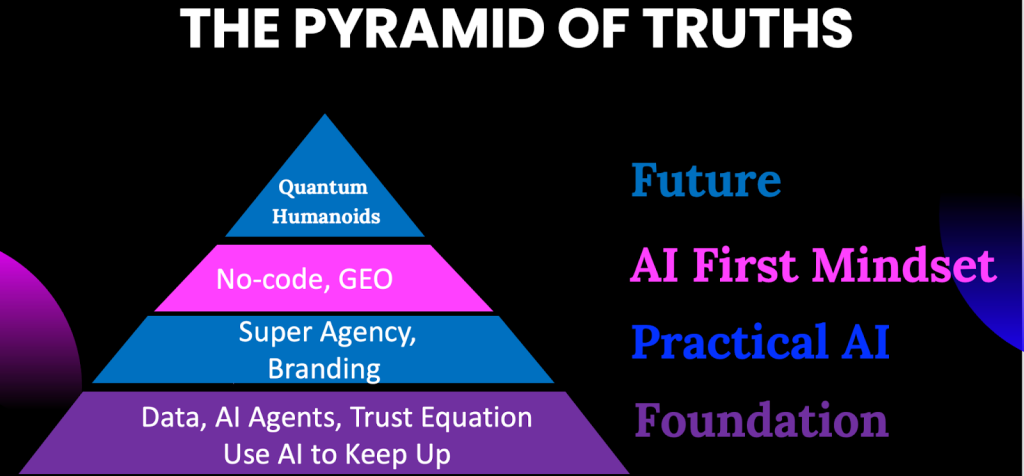What is an AI-First Strategy and Why is it Important?
AI-first strategy is being favoured by many technology companies, which is an approach where artificial intelligence is Integrated at the core of an organization’s strategy, decision-making, and daily operations. This means prioritizing ai above all else and integrating them across business functions to create efficiencies, improve services, and drive growth. This approach uses AI algorithms, like generative AI and machine learning models, to enhance decision-making, automate tasks, personalize customer experiences using natural language processing, and improve decision-making.
According to my book AI First Human Always, An AI-first strategy means putting artificial intelligence at the heart of your business. AI-first company integrates AI capabilities into its core functions rather than using it as a secondary tool. This strategy means representing a broader innovation strategy, where ai technologies as the central focus of strategy and decision making rather than just an add on.
The Importance of AI in Modern Business
The potential benefits of AI are wide, ranging from improving customer experience to driving business growth through predictive analytics and automation. By prioritizing businesses leveraging AI capabilities to optimize processes, streamline operations, and deploy AI solutions that enhance both internal efficiency and customer satisfaction. Using AI models in customer service, for example, can respond more quickly, cutting down on wait times and improving the user experience and fulfilling customer needs . AI can also help businesses remain competitive by seeing new opportunities and enhancing their capacity to react to shifts in the market.
Why go AI-first?
Simply put, integrating AI into every aspect of your operations can drastically improve efficiency, personalize customer interactions, and help you stay ahead of the competition. For instance, conversational AI in customer service can reduce response times, improve customer satisfaction, and free up your team to focus on more complex issues. Predictive analytics can streamline inventory management by accurately forecasting demand, minimizing waste, and reducing costs.
Implementing AI First in Organizations
To successfully implement an AI-first approach, you need a clear roadmap. As illustrated in my “Pyramid of Truths,” start by establishing a strong foundation—data, AI agents, and trust. Use AI proactively to stay competitive. Next, focus on practical AI applications like supercharging your branding efforts and improving agency capabilities. Move upward with no-code solutions that democratize AI, making it accessible to all business roles, and embracing geo-specific applications. Ultimately, the pinnacle represents future-facing technologies such as quantum computing and humanoid interfaces, embodying an innovative AI-first mindset.

Steps to Integrate AI into Business Processes
To implement an AI-first strategy, companies need to begin by integrating AI into existing processes. This involves assessing current operations, identifying areas where AI can add value, and then selecting the right AI solutions to drive those improvements. For example, conversational AI can be deployed in customer service centers to handle repetitive queries, while predictive analytics can be used in inventory management to forecast demand more accurately.
The first step is always to ensure that a company has a strong data foundation, as AI models rely heavily on training data to function effectively. Without solid data, the AI lifecycle cannot be optimized, and the algorithms will fail to deliver meaningful results.
How AI Solutions Improve Operational Efficiency
Once AI is integrated, businesses often see immediate improvements in operational efficiency. Use of AI reduces human error and free up valuable resources for more complex work by automating repetitive tasks. AI algorithms can optimize resource allocation, improve workflows, and streamline supply chains. This leads to faster decision-making, improved product recommendations, and a more personalized ai-first approach appears.
Challenges When Adopting an AI First Strategy
Technological Barriers to AI Implementation
The biggest challenge in adopting an AI-first strategy often lies in technological readiness. AI implementation requires advanced infrastructure, including high-performance computing resources, cloud storage, and AI development tools. Additionally, businesses must ensure they have access to relevant data to train AI models effectively.
Another hurdle is the need to continuously update AI systems to adapt to new AI technologies and algorithms. Failing to stay ahead of AI trends can quickly render an organization’s AI efforts obsolete.
Overcoming Organizational Resistance
Employees who fear losing their jobs or who are unaware of the benefits AI offers frequently oppose its integration into a company. Clear communication and employee support are necessary to overcome this resistance, and these can be obtained by showcasing how utilizing AI will improve human capabilities rather than replace them. Businesses should also be aware of the ethical issues surrounding AI, such as data security and privacy, and make sure that AI projects comply with legal and ethical requirements.
AI First Roadmap: Planning and Execution
Establishing Clear AI Objectives
A successful AI-first strategy begins with setting clear strategic priorities for AI adoption. This means identifying business objectives that AI can support, such as enhancing customer experience or improving operational efficiency. AI should be used to solve specific problems, and the outcomes should be measurable.
An AI-first company should prioritize AI-driven innovation in its roadmap, continuously improving and refining AI models to stay ahead of the competition. This iterative approach ensures that AI solutions evolve to meet changing business needs.
Creating an AI Integration Plan
After defining AI objectives, organizations need a detailed AI integration plan. This plan should outline how AI will be deployed across different business functions, such as sales, marketing, operations, and customer service. It should also include timelines, key milestones, and resource allocation. Establishing a robust AI transformation roadmap is crucial to keep AI initiatives on track and aligned with the broader business goals.
AI First Culture
Building a Culture that Prioritizes AI
Creating an AI-first culture means encouraging an environment where AI is seen as an essential tool for business growth and innovation. To create and improve AI solutions that support company goals, it involves promoting cooperation between data scientists, engineers, and business leaders.
To guarantee that everyone is aware of AI’s potential and capabilities, companies must also give top priority to AI training at all levels, from front-line employees to leadership. Investing in AI literacy and integrating it into the company’s values will be necessary to create this culture.
Aligning Leadership and Teams for AI Success
The leadership team must be fully committed to the AI-first vision and actively drive AI adoption within the organization. This includes making AI a central part of the company’s strategic objectives and allocating necessary resources for AI projects. It also involves addressing any concerns from employees and stakeholders by providing clear and transparent communication about the benefits and challenges of approach to ai.
Training Employees for an AI First Mindset
Developing AI Skills Across the Workforce
An essential part of transitioning to an AI-first organization is training employees for an AI-first mindset. This involves upskilling the workforce with AI-related skills, whether through formal education, internal workshops, or partnerships with AI development platforms. Training employees in data and AI helps bridge the skills gap and equips them with the tools they need to work alongside AI systems.
Encouraging a Growth Mindset for AI Adoption
Developing a growth mindset across the organization is critical for long-term AI adoption. Promoting employees to see AI not as a threat, but as a tool for innovation, will help overcome initial resistance. Companies need to highlight the potential of AI to empower employees by reducing repetitive duties and enabling them to focus on more strategic, high-value work.
Overcoming Resistance to AI First Transformation
Mitigating Risks Associated with AI Transformation
AI adoption often brings with it concerns over data security, algorithmic bias, and job displacement. It is important for organizations to prioritize data quality and ensure that AI systems are transparent, ethical, and compliant with industry standards. Fostering collaboration between AI experts and business leaders can help mitigate risks and drive AI projects forward in a responsible manner.
Addressing Ethical Concerns and Public Perception
Organizations should remain vigilant about the ethical implications of AI, especially concerning privacy, bias, and job impacts avoiding its potential downfalls. Clear communication about the ethical standards being followed and the AI-first approach can help reduce public concerns and encourage trust in AI initiatives.
Conclusion:
An AI-first strategy involves prioritizing AI technologies across business processes to maximise the potential of ai and efficiency, improve customer experience, and promote innovation.
- Careful planning, the application of AI, and the removal of cultural and technological obstacles are all necessary for integrating AI.
- For an AI strategy to be successful, leadership alignment and the establishment of an AI-first culture are essential.
- A growth mentality and personnel training guarantee the organization’s long-term adoption of AI.
- Retaining trust and guaranteeing appropriate AI use need addressing ethical issues and reducing hazards.
- By leveraging AI in all aspects of business, organizations can position themselves as leaders in the digital age, driving business growth and ensuring long-term success.
- Careful planning, the application of AI, and the removal of cultural and technological obstacles are all necessary for integrating AI.
- For an AI strategy to be successful, leadership alignment and the establishment of an AI-first culture are essential.
- A growth mentality and personnel training guarantee the organization’s long-term adoption of AI.
- Retaining trust and guaranteeing appropriate AI use need addressing ethical issues and reducing hazards.
By leveraging AI in all aspects of business, organizations can position themselves as leaders in the digital age, driving business growth and ensuring long-term success.
